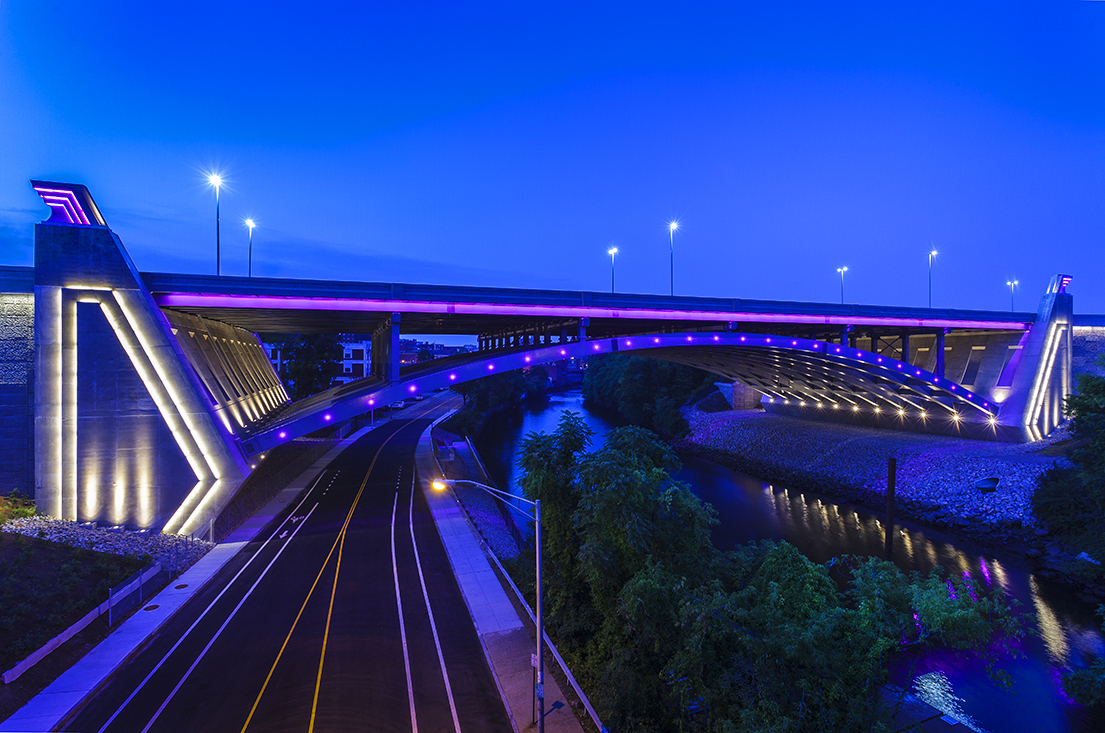Newport, RI – AIA Rhode Island, a chapter of the American Institute of Architects honored Northeast Collaborative Architects (NCA) with design awards for the Micro Lofts at the Arcade, Providence and the Pawtucket River Bridge. The annual competition celebrates outstanding works of architecture from Rhode Island architects and honors the project teams and clients who work with them.
The Micro Lofts at the Arcade earned the 2013 Merit Award in the Historic Preservation category. Micro lofts are innovative housing models that offer access to urban amenities at affordable prices. The Arcade was built in 1828 in the Greek Revival style and is regarded as the nation’s first enclosed three-story shopping mall. The $7 million adaptive reuse project respects the Arcade’s historic design, but the building is modernized with double-hung windows to bring in more light.
.The Pawtucket River Bridge earned the highest honor, the 2013 Honor Award for Urban Design.
NCA’s design challenge was not to create a linkage over a relatively narrow New England waterway but to convey the series of extraordinary events that for centuries converged at this very spot. From hand-hewn covered bridges to steel and concrete marvels, Rhode Islanders have long expressed pride in bridges and regard them as iconic structures.
The project entailed replacing three separate structures with a bridge to carry I-95 Northbound; a bridge to carry I-95 Southbound; and a bridge for the on and off ramps to George and School Streets. The new bridge’s four pillars feature representations of Art Deco wings on the eagles chiseled atop the tower at City Hall. Seen from the river, the bridge, made of metalized steel and illuminated at night with colored LED (light-emitting diode) lighting, displays a graceful silvery arch over the Pawtucket River. The project cost $80 million and was completed in 2013.
-more-
The Arcade was listed on the national register of historic places in 1971 and is notable not only for its striking architecture, which includes ionic columns at both entrances to the building, but also for the memories many Rhode Islanders have of strolling through the building. The Arcade had been shuttered for three years. In that time, the Providence Preservation Society placed it on its list of the city’s ten most endangered properties.
NCA created 48 innovative micro lofts on the Arcade’s second and third floors and 17 micro retail spaces on the main level. The furnished one-bedroom units range in size from 225 to 450sf and feature full bathrooms, built-in beds, seating, storage, as well as kitchens equipped with refrigerators, sinks, dishwashers, and microwaves. When residents need more space than their cozy individual units offer, they can take advantage of a game room, TV room and porches. The Arcade has other common amenities including on-site laundry, bike storage, locked basement storage units, and a parking garage across the street.
The jury was comprised of architects from Philadelphia, Pa. and their official comment about the Micro Lofts at The Arcade was, “The jury classified the project as a Historic Preservation achievement because it took a building of preeminent significance off of the endangered list. In so doing, the project provides multiple lessons about giving old buildings new life, while addressing contemporary needs for community and sustainable urban living. One of us summed it up: ‘When working in a historic building, this is exactly the type of outcome you want to see.’”
In 1958 a new Pawtucket River Bridge was built to carry I-95 traffic over the Pawtucket River. Native Americans call the place where trails meet to cross a river Pawtucket. During the 18th Century settlers crossed the Pawtucket River seeking religious freedom in Rhode Island Colony. During the 19th century, Pawtucket’s Slater’s Mill marked the birthplace of the Industrial Revolution and the bridge spanning the river became a commercial thoroughfare. By the mid-20th century, Interstate 95 was the most traveled highway in the nation.
According to the Rhode Island Department of Transportation, 162,000 vehicles travel across the Pawtucket River Bridge every day. The defective Route 95 overpass created an opportunity to demonstrate that State and Federal governments could collaborate with the design team to replace the aging Pawtucket River Bridge and revitalize the historic city’s gateway. Inspiration for the bridge’s Art Deco design came from other structures in Pawtucket built during the Great Depression, such as City Hall, McCoy Stadium and Shea High School.
The Jury’s official comment about the Pawtucket River Bridge was, “The world seems to have forgotten Architecture’s ability to infuse spirit into infrastructure in the public realm. The Pawtucket River Bridge is a powerful reminder of that potential. The jury recognized two major successes here: The design achievement itself, with kudos to the architects; and the wisdom of the public client in the act of commissioning an architect. We therefore gave it the highest award as an Urban Design achievement. The bridge exhibits a strong iconography, unique to this particular crossing, with its particular way of engaging the span with its abutments, and harkening back to the original bridge’s eagle-motif. The referential nature of these design moves are made contemporary and purposeful through the honest expression of structural form. Acting as an extension of the city in the landscape, it is both connector and gateway and will undoubtedly be memorable to Pawtucket’s innumerable visitors and residents. The jury was impressed with the weave of transportation modes that this structure creates. Walkers, bikers, boaters, and automobile passengers share the experience of this structure in distinct yet integrated ways.”












